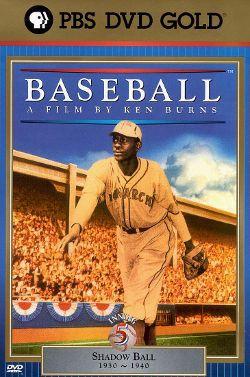Continuing on with the journey through Baseball: A Film By Ken Burns brings us to the decade of the 1930s. The United States, indeed, the world, was facing off against the Great Depression during the 1930s. As a result of high unemployment rates and widespread poverty, few could afford the price of tickets to attend professional baseball games, and as a result, attendance fell drastically. Baseball did what it could to try to draw fans back in, from the first All-Star game to the creation of the Baseball Hall of Fame. However, the financial difficulties that faced the nation at this time were too great.
Even as the Depression was getting underway, the Yankees signed Babe Ruth to the biggest contract in baseball history in the early 1930s. It was a move that seems only too-appropriate, given Ruth’s ostentatious lifestyle. Meanwhile, Lou Gehrig continues to stay merely in the shadows of the spotlight, in spite of his consecutive game streak and consistent high level of play.

Subtitled “Shadow Ball,” the Fifth Inning of this series by Ken Burns focuses on black baseball. (The subtitle, by the way, is not a reference to race, but rather to the illusion that these games weren’t being played with a ball at all, because it could barely be seen.) While white baseball suffered during the Depression, black baseball flourished. Many black teams came under control of racketeers, as they were among the few who could afford to fund baseball during this time, but interestingly, this seemed to be to the advantage of the Negro Leagues. And the crowds flocked to watch the black teams play. Listening to the nostalgia in the voices of former negro leagues players, you can tell there was a true love for the game, even in spite of inequality, the hard road trips, and the racism they faced.
We learn about Satchel Paige, considered by some to be the greatest pitcher in all of baseball. He had such an arsenal of pitches that few could hit off Paige. Some saw him as black baseball’s equivalent of a Babe Ruth, in that he drew large crowds to ball games. He even seemed to hold true to this comparison in his off-field personality. He hated to drive slow and cultivated a persona for those around him. Buck O’Neil, however, indicates there was much more to Paige than often met the eye.
Babe Ruth himself became the center of attention yet again during the 1932 World Series in Chicago when, in Game 3, he appeared to call his shot. No one will ever know for certain whether he really did, or if Ruth was merely engaging in a different gesture altogether, but it was a moment that, as we all know, has remained a part of the baseball psyche for decades. As the decade went on, however, Ruth’s level of play would decline, as it always does as a ballplayer gets older. When the Yankees made it clear they would not offer him a manager position, he did a brief stint with the Boston Braves, then retired from baseball. Meanwhile, new stars stepped into the spotlight. Not just Lou Gehrig, but also figures like Mel Ott, Jimmie Foxx, Dizzy Dean, and Bob Feller.
As for home run hitters in the Negro Leagues, catcher Josh Gibson was well-known for this ability. While many called him a black Babe Ruth, Burns notes, there were some who thought they had the comparison backwards, and that Babe Ruth was actually a white Josh Gibson. Indeed, the list of accomplishments for Gibson certainly seems to pass those of Ruth, including a season with seventy home runs, some of which exceeded 575 feet in distance. The Negro Leagues’ version of the Yankees were the Kansas City Monarchs, led by first baseman Buck O’Neil. In his commentary, O’Neil speaks about the camaraderie between the players and the fans.
We learn about the 1930s Brooklyn Dodgers, “dem bums,” and we learn about the 1934 St. Louis Cardinals, the “Gashouse Gang.” In 1936, Joe DiMaggio made his first appearances as a rookie with the New York Yankees. DiMaggio would help lead the Yankees to four World Series. Also in the thirties, we see the first night game in Major League Baseball (though night games had been played in the Negro Leagues for some time) and the increasing popularity of radio broadcasts, especially those by Red Barber, created new fans, as more and more people came to understand the game.
During the off season, many black players traveled south to Mexico, Latin America, and the Caribbean. In doing so, they were able to play baseball year round. They also discovered that the racial attitudes south of the United States were very different. They were paid more and welcomed more warmly by the locals than they were back home.
Discrimination didn’t stop with just the black population. Hank Greenburg came into prominence as first baseman for the Detroit Tigers. He wasn’t the first Jewish player in the game, but he was probably the first to really make a name for himself. Greenburg faced a considerable backlash of anti-Semitism, but his stellar play eventually helped to win fans and players over. Greenburg felt his role was of particular importance in light of the actions of one Adolf Hitler in Europe.
In 1939 came Lou Gehrig’s ALS diagnosis, and thus the end of his streak and his baseball career. On July 4th of that year, Gehrig gave his “Luckiest Man” speech at Yankee Stadium. Two years later, he passed away from the disease, which now bears his name.
1939 also saw the opening of the National Baseball Hall of Fame and the induction of the first Hall of Fame class. It was the 100-year anniversary of the myth of Abner Doubleday‘s founding of baseball in 1839. The disc then ends with Buck O’Neil describing the long-awaited matchup between Satchel Paige and Josh Gibson — Negro League Baseball’s best pitcher versus it’s best hitter. O’Neil’s account left me with a smile.




